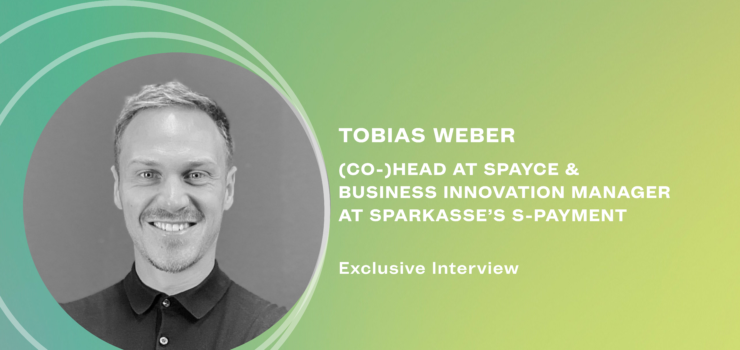Article

Ideas are useless until used: Interview with Tobias Weber, (Co-)Head at SPAYCE & Business Innovation Manager at Sparkasse’s S-Payment
The digital payments industry is constantly evolving, with new and exciting innovations being introduced every day. From contactless payments to cryptocurrency, the industry is pushing the boundaries of what is possible and has opened up a world of possibilities for other industries such as retail.
The German Savings Banks play an important role in driving such innovation forwards. They have invested heavily in digital technologies, such as mobile banking, online banking, and artificial intelligence, to provide customers with a more convenient and secure banking experience. They have also developed innovative products and services, such as digital wallets and payment solutions, to meet the changing needs of their customers.
An interesting player in the field is SPAYCE, a Payment Innovation Lab that provides digital and inventive solutions for payment transactions to both private and corporate customers of the Saving Banks Group, and it serves as a bridge for the exchange of knowledge between LBBW and S-Payment, Sparkasse Finance Group’s payment competence center, thus enhancing the innovation processes of both companies.
As a (Co-)Head of SPAYCE and a Business Innovation Manager at S-Payment, Tobias Weber, is actively working to foster innovation with startup speed and scalability for the German Savings Banks Group.
We had the chance to chat with Tobias to gain an inside look into the innovation processes within SPAYCE. From the key factors that help them make the best selection of new products and technologies, to the exciting digital products they are currently working on, and what payment innovations retail companies should consider in 2023 – this interview has it all!
1. Could you please introduce yourself and tell us more about the role of SPAYCE (Payment Innovation Lab) to help Sparkassen-Finanzgruppe develop digital and innovative solutions?
Thanks for having me! I’m currently Co-Head of SPAYCE, the Payment Innovation Lab, and Business Innovation Manager within S-Payment. SPAYCE is a joint initiative of S-Payment GmbH, Sparkasse Finance Group’s payment competence center, and Landesbank Baden-Württemberg (LBBW) with the main goal of developing payment-related product ideas in an iterative, customer-centric, and resource-efficient way. The idea that “ideas are useless until used” was a central thought when we started in 2019.
Today, we have successfully positioned SPAYCE within both mother-corporations as well as within the Savings Banks Group as an open platform for cross-company collaboration with the main goal of fostering innovation execution. We work on ideas with interdisciplinary teams composed of experts from both corporations as well as from further partners, such as large companies and startups. This is because we are looking for the skills and know-how we need to validate and execute the innovation idea in the best way, since the so-called back-end of innovation is the most important part for us.
Additionally, we also (of course) screen the latest trends in our industry, try to understand their impact, and ideate new solutions. In short, we work on both the front-end and back-end of innovation. However, our aim is not to create any innovation theater; rather, we strive to deliver executable innovation ideas that come to fruition in the best case. Ideas that in the best case finally come to reality.
This is not always possible in a short period of time, but with the right expectation management, we are confident that we can deliver the best value for our mother-corporations when we accompany the idea elaboration over a longer period for real validation.

2. Could you give us an overview of the innovation processes within your organization? What are the key factors that help you make an optimal selection of new products and technologies? And, what are some interesting digital products that you are currently working on?
Selecting new trends and ideas to work on always depends on different factors. One important factor for us is to take a customer-centric perspective. Sometimes this is difficult when we face a mainly technology-driven trend. Nevertheless, without seeing real potential from a customer’s point of view, we usually don’t start the idea elaboration. Of course, we have further key factors such as potential market impact (considering our industry) or time to market.
Furthermore, given our circumstances with SPAYCE and the fact that we want to foster innovation execution, it is also important for us to stick to the following rule: “Ignore the noise and focus on few things that matter (potentially).”
When we start the idea elaboration, we always follow an iterative process. For example, we start a 1 or 2 week design sprint with a decision gate at the end, followed by an incubation phase which takes several months with several decision gates in between. More or less, these are cross-industry standards with little twists in order to make them suitable for our specific corporate environment, I would say. An important part of this process is to include the right decision maker in order to prevent the not-invented-here problem at a later stage.
Current topics that we are watching and also currently working on are around NFTs, Metaverse and additional services for the digital wallet. One of the last examples is “Toni Token” (weltspartag-nft.de) , the first utility NFT we dropped in 2022 as the first pilot within the saving banks group. We also currently observe the use cases around the top trend AI.

3. Various factors, including the pandemic, have imposed a change to Germany’s cash-dominated economy, helping the cashless and contactless market to grow. How do you see this trend evolving in the future and how do S-Payment and SPAYCE contribute to the acceleration of digitized payments?
The digital and contactless payment trend is out of question. Looking at the statistics, the pandemic was surely an accelerator. When we furthermore look towards the demographic change, the customer behavior will continue to change and will move towards the use of digital payment methods, also for payments of smaller value.
Mobile payment will be core in the future and will continue to become more and more convenient with further services related to the payment process. As the largest banking group in Germany, the saving banks are in a lead role in general and as S-Payment and SPAYCE, where we focus on payment innovations, we can make a real impact.

4. What payment innovations should retail companies consider in 2023?
Currently, there are different trends that we observe in retail which are partly not really new but gain momentum.
The first example is increasing interest in easy acceptance solutions such as NFC capable smartphones as an acceptance medium. Therefore, we already have product solutions in place to offer smaller or medium-sized retailers a good mobile solution (www.sparkasse-pos.de). Based on this, there will also follow additional services for retailers to make the solution even more convenient.
Secondly, seamless checkout solutions are of interest. Big retailers are currently experimenting and testing different approaches. Speaking of self-scanning systems and checkin/checkout solutions, one step ahead, we see “walk through” systems where the customer neither has to scan the products nor have to scan any QR code to check-in or check-out. In this approach the customer just walks in the store, picks the items and leaves. The tracking and payment will happen totally in the background and invisible for the customer.
Thirdly, of course we observe how retailers look and act related to the metaverse trend. It is important for us to see which use cases are of interest and what experiments work and fulfil a customer need or desire. But this is definitely something where the real execution is further away in time, apart from the experiments we observe at the moment. Nevertheless, it is important to observe these first steps carefully and to prepare to act accordingly.

About Tobias Weber
Tobias Weber is an experienced innovator and consultant with a decade of experience in the area of innovation management. His passion lies in payments, and he is currently building SPAYCE (Payment Innovation Lab) from scratch as a joint initiative with LBBW. His goal is to foster innovation with startup speed and scalability for the savings banks group. He has experience in Retail Banking (especially Payment), Automotive, Aviation & Production Industry, and is a lecturer for Payments & Innovation at Baden-Wuerttemberg Cooperative State University.
About Author
Elena Dimoska is a communications & marketing enthusiast with great passion to communicate value in a way that reinforces business success beyond revenue growth.
One of her missions as part of TrueNode is to internalize the topic of innovation and digital transformation in large enterprises and to help more well-known brands leverage innovation to make impact. For that purpose, Elena is interviewing innovators from well-established brands across Germany and Europe.
Are you innovating to make an impact? Email Elena to get featured.
What challenges does your organization face in scaling digital innovation?
Get in touch – we’d love to discuss the potential solutions!






